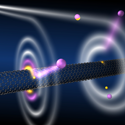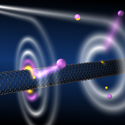Ionizing atoms with a nanotube
The extremely large electric fields that can be produced near the tips of carbon nanotubes suggests their potential use as electron field emission sources for low-power video displays or as highly sensitive gas detectors. But nanotubes often come in macroscopic bunches of irregular length whose electric field is difficult to characterize and whose geometry is not optimized for efficient ionization of atoms.
In a recent paper published in Physical Review Letters, Anne Goodsell, Trygve Ristroph, Jene Golovchenko, and Lene Vestergaard Hau from Harvard University, US, have used the side wall, rather than the tip, of a single charged carbon nanotube to ionize individual ultracold atoms, which they detected one-by-one. Using the field from the entire wall of a tube gives a much higher likelihood of “capture,” as does the use of slow-moving, ultracold atoms.
In the experiment by Goodsell et al., a cloud of neutral rubidium atoms cooled to is launched upward toward a charged nanotube that lies horizontally across a - -wide hole in a silicon structure. The nanotube polarizes atoms nearby, and an atom within a threshold distance spirals rapidly toward the wall. Eventually an electron tunnels from the atom to the tube, creating an ion that is ejected and measured by a detector.
The experiment combines nanotechnology with cold atoms to demonstrate a new type of high-resolution, single-atom, chip-integrated detector that may ultimately be able to resolve fringes from the interference of matter waves. The authors also foresee a range of single-atom, fundamental studies made possible by their setup. – David Ehrenstein





